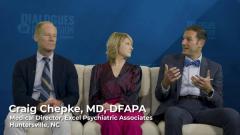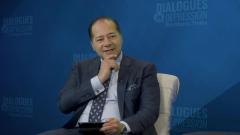
Current Landscape of Rapid-Acting Therapies for MDD
Experts highlight the current and prospective therapies for patients with MDD, highlighting key similarities and differences in patient pathophysiology, drug onset of action, and overall therapeutic limitations.
Episodes in this series

Transcript
Gus Alva, MD, DFAPA: What I’d like to do now is kind of spin things a little differently. In comparing the mode of action, and pharmacological profile of rapid-acting therapies to traditional antidepressants, I’d like to get your opinions on the implications of the differences in managing major depressive disorder with several things. I guess for the sake of the discussion that we’re going to have right now regarding this piece, but I’d like you guys to consider our rapid-acting therapies, meaning [those] that are working within 1 week, right? And I think that a classic treatment that oftentimes gets relegated to a much more segregated view would be something like electric convulsive therapy [ECT], right? So what I’d like you to talk about are themes tied in with things that are rapid-acting, meaning within 2 weeks, that might include ECT, transcranial magnetic stimulation [transcranial magnetic stimulation]. Yeah, you mess with the same protocol. [Craig was] commenting on neurosteroids. It’s specifically brexanolone, now we’ve got zuranolone as well. Accommodation dextromethorphan with bupropion certainly fits in within that particular bill also. We’ve got a couple of atypical antipsychotics, aripiprazole and brexpiprazole, that also would slide into that particular mix. And it’s a type of extended-release also. Psilocybin, ketamine, esketamine, right? So maybe if you can think about these particular modalities, what is a shared commonality? What’s a subtle difference between them? What are your thoughts between those things?
Craig Chepke, MD, DFAPA: I brought up as esketamine because I think all of us have ketamine clinics. I find that it’s good to relate it to some of the neural modulatory techniques. It’s an intermittent treatment. It’s not something that’s taken daily. Esketamine is intranasal, patients self-administer it, [it’s] approved for both treatment-resistant depression as well as major depressive disorder with acute suicidal ideation, as you mentioned, Greg. It’s something that can really have an effect for the patients who are extraordinarily sick.
Gus Alva, MD, DFAPA: Although that would be for treatment-resistant depression, right? So there’s a subtle difference there and maybe that might limit a specialized center being able to administer it.
Craig Chepke, MD, DFAPA: Exactly, that is the major drawback.
Gus Alva, MD, DFAPA: Like you said, the commonality of [what you all] have is that we actually have the availability of doing this for our patients. Not every place will do so. Greg?
Greg Mattingly, MD: You know what all of those treatments have in common? None of them are raising monoamines by themselves, right? None of them are monoamine reuptake-inhibiting antidepressants. So they’re not SSRIs [selective serotonin reuptake inhibitors], SNRIs [serotonin-norepinephrine reuptake inhibitors], tricyclics, bupropion—none of those are reuptake inhibitors. What they’re all hitting is neuromodulation or specific receptor subtypes. And we know that when you modulate a receptor subtype directly, you can have faster onset. We know when we turn on neural network connectivity or pulse a neural network, we can have faster onset. We know when we hit that GABA [γ-aminobutyric acid]-glutamate junction directly, we can have faster onset. So I was thinking…what do all those things not have in common? What they all aren’t are monoamine reuptake inhibitors. They all hit the brain in a different way.
Gus Alva, MD, DFAPA: I love the fact that you initiated with a treatment-resistant kind of a paradigm. And now we can distill it over into run-of-the-mill, major depressive disorder, and then specifically take a look at that. Although, as some might say, TMS and ECT would be relegated toward, again, individuals who would have already exhausted other things, right? And in the sense of the augmentation situation, that’s not necessarily treatment-resistant, but it’s going down the line. But it comes back to Greg’s previous point, and that is that we absolutely do need to revisit guidelines that we have at the present time, and maybe this seminal point in which we’ll initiate that discussion and be able to move this and propagate it further so that people can get that benefit that they lack.
Greg Mattingly, MD: What if guidelines pose the question? I’ll ask Erin this, because you see a lot of people. You’re in the mills, clinicians, seeing people in Pennsylvania. What if guidelines emphasize getting people well quickly and keeping them well? And that’s where things ranked. The faster I get you better, and if I keep you better, that’s at the top of the hill. How would that change the way our treatment guidelines are? It would turn them upside down.
Erin Crown, MHS, PA-C: Going back to the issues of where do these modulation drugs fall into line compared to ECT and TMS, one of the places that, coming from rural Pennsylvania, it’s important to think about where they fall in line, is accessibility. So my patients can’t access TMS. My patients can’t access ECT. They can access an oral agent. So that’s really important for us to consider.
Gus Alva, MD, DFAPA: Obviously, I embedded in there a couple of investigational agents also that we’re excited about. But to have that common modality, that there’s going to be a rapid onset benefit.
Erin Crown, MHS, PA-C: Then even if the guidelines got flipped upside down, with our oral agents, accessibility still would not necessarily be a problem in flipping those guidelines upside down for the better of all of us.
Craig Chepke, MD, DFAPA: So something else I want to highlight about what you said, Greg, is that the direct receptor modulation [doesn’t just bring] speed, it brings specificity as well. Because when you block a monoamine reuptake pump, let’s say serotonin, you’re flooding the synapse with serotonin. We know of at least 14 serotonin receptors. There’s probably more. We’re just not smart enough to find them yet. And we don’t want to stimulate all of those and agonize them indirectly, because just like there’s good cholesterol and bad cholesterol, there are good serotonin receptors and bad serotonin receptors, so to speak. And so, with the specificity of direct receptor modulation, you can avoid some of the off-target effects that can happen. For instance, one thing that I notice with the glutamatergic agents, we generally don’t see sexual [adverse] effects. We generally don’t see them waking with these agents. Those are the 2 deal-killer [adverse] effects for patients with major depression and any condition really. And to not have a profile that is very heavy in those adverse effects for the glutamatergic agents, that’s huge for patients. That’s a huge victory for them.
Erin Crown, MHS, PA-C: That goes back to quality of life. Let’s talk about sex, right? It matters. It’s important to confront that with our patients and listen if they’re brave enough to tell us. But so many will either simply stop their medication, suffering in silence…or they’ll just deal with it, thinking that they don’t have a choice other than to be depressed. And that’s just not reality.
Greg Mattingly, MD: I’m going to flip that back. It’s not just the physical [adverse] effects with antidepressants. It’s the emotional [adverse] effects. Emotional blunting. The number one sexual organ in the body isn’t what’s below the waist, it’s what’s above the shoulders. And if you have anhedonia, if you have emotional blunting, if you’re not feeling joy and pleasure, [then] your thinking about intimacy, your fantasizing about intimacy, thinking about your partner, your spouse, the person you want to be with, all of that diminishes. So I think these new agents…help with that. I don’t think they hurt that. I think they improve anhedonia. I think they improve libido. So thinking about intimacy is a really interesting component.
Gus Alva, MD, DFAPA: I love that you were all threading through part of the reason by which we sometimes label individuals as being treatment-resistant. It’s not just that something might not be a good fit for them based on an efficacy point of view. But it might be not necessarily the best fit tied in with the [adverse] effect profile associated with. As a consequence of that, people have to ditch out on that effort. And I think you’re absolutely right that these new agents do present a new paradigm that appears to be maybe better suited for a lot of people.
Transcript was AI-generated and edited for clarity.
Newsletter
Receive trusted psychiatric news, expert analysis, and clinical insights — subscribe today to support your practice and your patients.




























